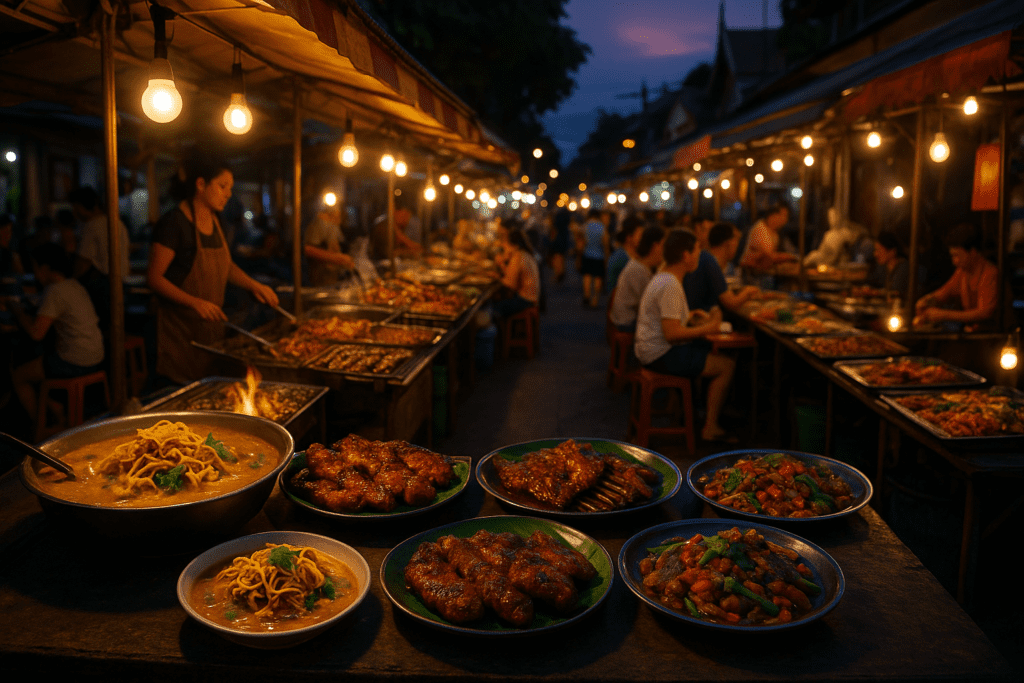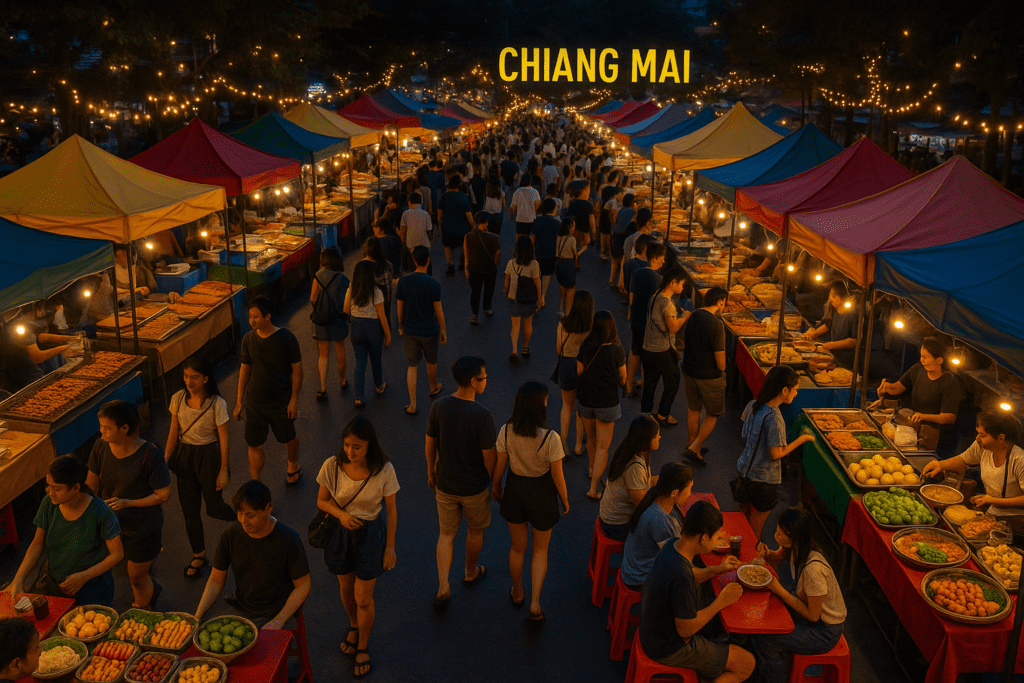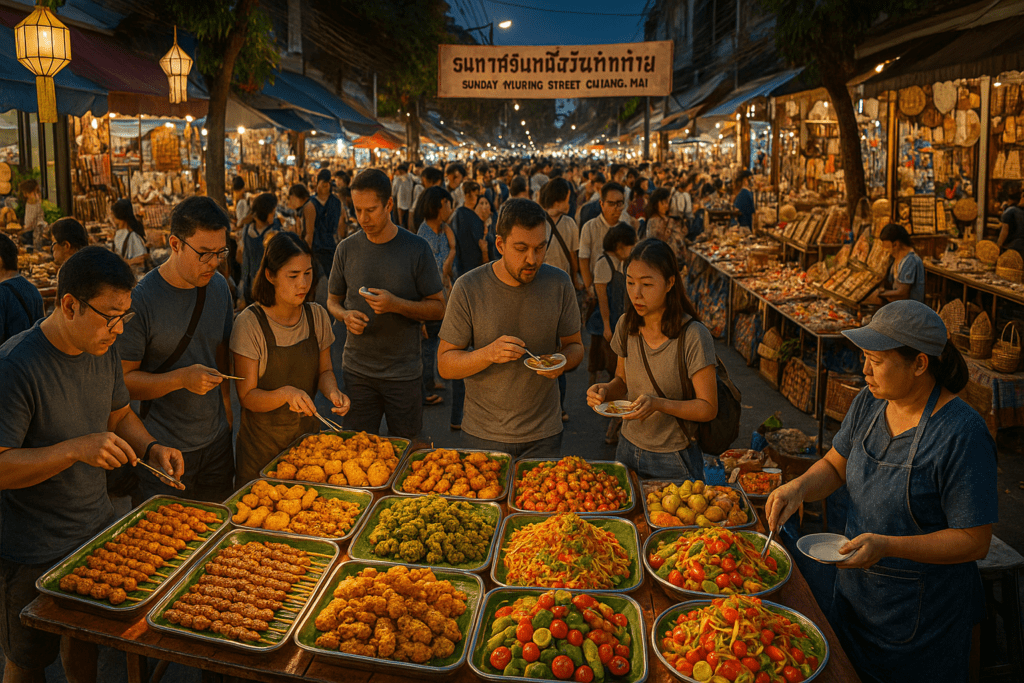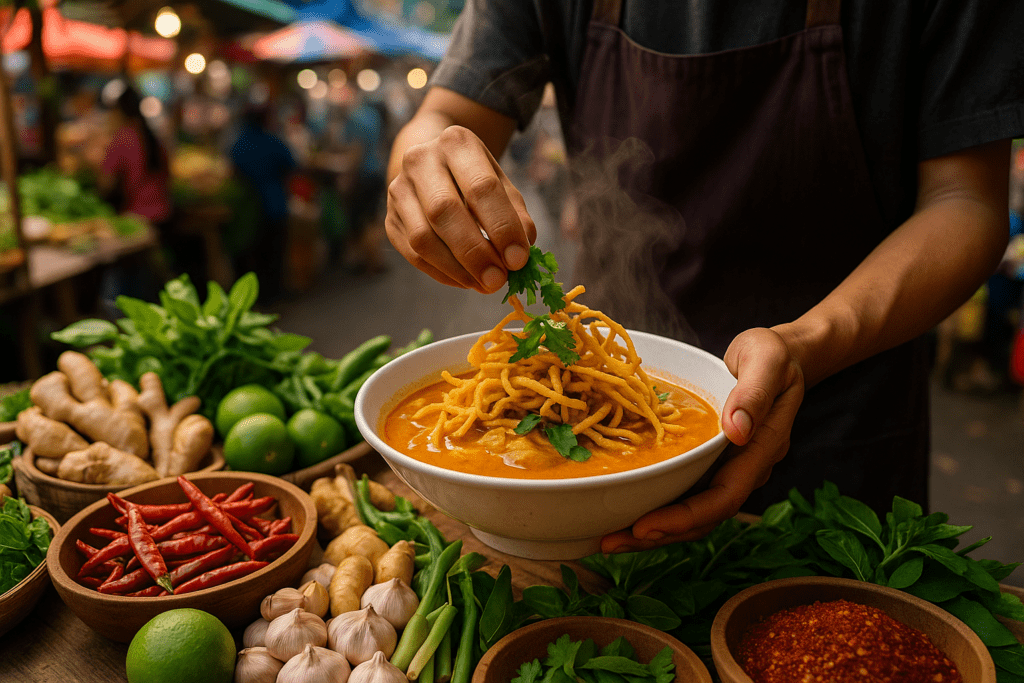Estimated reading time: 12 minutes
Key Takeaways
- Chiang Mai’s street food scene offers authentic Northern Thai flavors through iconic dishes like Khao Soi and Sai Ua sausage
- The Old City serves as the historic heart of street food culture, with the best concentration of authentic vendors
- Night markets like Chang Phueak and Sunday Walking Street provide unique evening dining experiences with festival-like atmospheres
- Street food culture in Thailand gained popularity in the 1960s and has become deeply integrated into daily life
- Essential safety tips include choosing busy stalls, staying hydrated, and starting with milder dishes for sensitive stomachs
- Having your own transport, like a rented motorbike, provides maximum flexibility to explore hidden gems and local favorites
Table of Contents
- Dive into the Heart of Northern Thai Flavors
- Why Chiang Mai Street Food Is a Must-Do Experience: More Than Just a Meal
- Where to Eat in Chiang Mai: A Food Lover’s Map to Top Districts & Hidden Gems
- Best Food in Chiang Mai: Signature Dishes You Absolutely Can’t Miss
- Chiang Mai Night Market Food: Feasting After Dark
- Sunday Walking Street Food: A Weekly Culinary Festival
- Practical Tips for Your Ultimate Chiang Mai Street Food Tour
- Your Chiang Mai Street Food Adventure Awaits!

Dive into the Heart of Northern Thai Flavors
Embark on an unforgettable culinary journey through Chiang Mai street food, a vibrant tapestry of tastes, sights, and sounds that represents the very heart of Northern Thai culinary culture. This immersive experience goes far beyond simply eating – it’s a full sensory adventure where the sizzling sounds of woks, aromatic clouds of steam, colorful displays of fresh ingredients, and the lively buzz of local life create an authentic connection to centuries-old traditions.
The magic of Chiang Mai’s street food scene lies in its accessibility and authenticity. Food stalls appear on practically every corner, from individual sellers with rickety little stalls to open-air shops where locals and tourists alike gather to share meals and stories. These markets serve as vibrant social hubs that showcase the heart and soul of Thai culture, making them an essential destination for any visitor seeking genuine cultural immersion.
From the iconic creamy richness of khao soi Chiang Mai to the bustling atmosphere of Chiang Mai night market food and the festival-like energy of Sunday walking street food, this northern city offers some of the best food in Chiang Mai – dishes that have been perfected over generations and continue to evolve while honoring traditional recipes and techniques.

Why Chiang Mai Street Food Is a Must-Do Experience: More Than Just a Meal
A Rich History Develops
The street food culture that defines modern Chiang Mai has fascinating historical roots that stretch back decades. While floating market food has been sold from boats for over two centuries, street food as we know it today became highly popular in Thailand only in the early 1960s. The proliferation of this culinary phenomenon resulted from several converging factors: significant Chinese immigrant influence bringing new cooking techniques and flavors, Thailand’s rich agricultural heritage providing abundant fresh ingredients, rapid urbanization creating local demand for convenient meals, and rising interest from foreign visitors seeking authentic experiences.
Thai street food culture became commonplace throughout the country in the 1970s and has since become an integral part of daily life, effectively “displacing home-cooking” in many urban settings. This transformation reflects how deeply food culture can evolve and adapt while maintaining its essential character and quality.
Lanna Traditions & Local Ingredients
Chiang Mai street food is deeply intertwined with the region’s Lanna cultural identity, particularly within the Old City where ancient walls and moats create a concentrated area where these culinary traditions are preserved and celebrated. The use of fresh, local ingredients defines Northern Thai cuisine – aromatic herbs like lemongrass and galangal, distinctive spices, and unique vegetables often sourced from nearby mountains and farms create flavor profiles that are distinctly different from other regions of Thailand.
The Communal, Festival-Like Atmosphere
Street food in Chiang Mai creates a genuinely communal experience where people from all walks of life gather around plastic tables and metal stools, sharing conversations and discovering new flavors together. Street vendors rely heavily on their reputation among locals, ensuring consistently high quality throughout the markets and creating trust that extends to visitors. This culture generates a festival-like atmosphere where food becomes a vehicle for social connection and cultural exchange, turning every meal into an opportunity for authentic human interaction.
Where to Eat in Chiang Mai: A Food Lover’s Map to Top Districts & Hidden Gems
The Old City: The Historic Heart of Flavor
Chiang Mai’s Old City stands as the undisputed center of the city’s exceptional street food scene, with countless vendors offering authentic local cuisine within the historic walls and moats that define this ancient area. The areas along the old city moat feature numerous stalls selling everything from traditional Northern Thai specialties to sweet treats and refreshing beverages, creating a continuous feast for the senses as you explore the historic streets.
Morning markets within the Old City walls provide excellent opportunities to sample breakfast favorites among locals, with venues like Warorot Market (Kad Luang) and Somphet Market offering everything from steaming bowls of rice porridge to crispy Thai donuts that fuel the local workforce for their day ahead. For more insights into Chiang Mai’s vibrant market scene, check out our Best Chiang Mai Local Markets post.
Nimman Road & Santitham: Trendy Bites and Local Haunts
Nimman Road has earned recognition for its trendy cafes and modern establishments, but it also hosts upscale, contemporary street food stalls and food courts that are particularly popular with university students and expatriate residents. This area provides a fascinating glimpse into how traditional street food evolves to meet changing tastes while maintaining its essential appeal.
Santitham offers a more authentically local neighborhood experience, with budget-friendly street food options that provide visitors a genuine glimpse into everyday Chiang Mai life. The vendors here cater primarily to residents rather than tourists, resulting in consistently excellent quality at remarkably affordable prices.
Chang Phueak (North Gate) Night Market: The Legendary Night Owl Scene
The Chang Phueak Night Market has achieved legendary status among dedicated food enthusiasts, particularly for late-night dining experiences. This famous location hosts specific vendors like the renowned “cowboy hat lady” who serves exceptional khao kha moo (braised pork leg) that draws long lines of eager customers throughout the evening hours. The bustling atmosphere after dark and popularity with both locals and tourists seeking iconic dishes makes this market an essential stop for serious street food exploration.
Riverside & Lesser-Known Sois: Authentic Local Fare Off the Beaten Path
The areas along the Ping River offer restaurants and food stalls with scenic views and a more relaxed atmosphere, perfect for those seeking a quieter dining experience without sacrificing quality or authenticity. Exploring smaller sois (alleys) reveals truly hidden gems and local specialties that most visitors never discover.
Discovering these diverse neighborhoods and understanding where to eat in Chiang Mai can be an adventure in itself. Having your own transport, like a rented motorbike from a service such as Byklo.rent, can give you the freedom to explore winding sois and local markets beyond the main tourist areas, truly uncovering the hidden best food in Chiang Mai at your own pace. For insider tips on renting two-wheelers and finding the best deals, see our Motorbike Rental Chiang Mai Guide.


Best Food in Chiang Mai: Signature Dishes You Absolutely Can’t Miss
Khao Soi Chiang Mai: The Iconic Northern Noodle Soup
Khao soi Chiang Mai stands as perhaps the most iconic Northern Thai dish – a creamy, mildly spicy coconut curry noodle soup typically served with tender chicken or beef, topped with crispy fried noodles, pickled mustard greens, finely sliced shallots, and a fresh lime wedge. This complex dish balances rich coconut flavor with aromatic curry spices and provides textural contrast through its combination of soft noodles and crunchy toppings.
This signature dish represents a must-try experience when visiting the Old City, where numerous vendors offer their unique interpretations of this beloved recipe. The best versions feature homemade curry paste and noodles that are cooked fresh throughout the day.
Sai Ua: The Aromatic Northern Thai Sausage
Sai Ua represents one of Northern Thailand’s most distinctive contributions to the country’s culinary landscape – a grilled pork sausage packed with fragrant herbs and spices including lemongrass, kaffir lime leaves, galangal, and chilies that create a complex, intensely aromatic flavor profile. These sausages are often displayed coiled on smoking grills, and their enticing smell alone draws customers from considerable distances.
Nam Prik Ong & Nam Prik Noom: Flavorful Chili Dips
These traditional dips represent staples of Northern Thai cuisine that reflect the region’s agricultural heritage and skill with preserving and intensifying flavors through careful preparation techniques.
Nam Prik Ong features a pork and tomato-based chili preparation that offers a milder, slightly sweet flavor profile that appeals to those who prefer less intense heat. Nam Prik Noom provides a spicier experience, made from roasted green chilies, garlic, and shallots that deliver a smoky, complex kick that builds gradually.
Both dips are typically served alongside sticky rice, fresh or steamed vegetables like cucumber, cabbage, and long beans, and sometimes accompanied by crispy pork rinds that provide satisfying textural contrast.
Gaeng Hang Lay: Rich and Savory Northern Pork Curry
Gaeng Hang Lay represents a rich, intensely fragrant pork belly curry that shows clear Burmese culinary influence through its characteristic blend of flavors. This dish features tamarind-based sourness balanced with sweetness from palm sugar and aromatic spices including ginger, garlic, and turmeric, notably prepared without coconut milk unlike many other Thai curries.
Mango Sticky Rice & Other Street Desserts (Khanom Wan)
Mango Sticky Rice (Khao Niao Mamuang) serves as Thailand’s most famous dessert – sweet sticky rice topped with fresh mango slices and generously drenched in rich coconut cream that creates perfect harmony between textures and flavors.
Khanom Krok offers small, grilled coconut pancakes that are crispy on the outside while maintaining a soft, custardy interior that provides intense coconut flavor in every bite. Street vendors also offer various jellies, sweet soups, and fried bananas that showcase the creativity and skill of local dessert specialists.
Chiang Mai Night Market Food: Feasting After Dark
The Allure of Evening Eats
Night markets represent a significant aspect of Thai street food culture, with evening hours being prime time for serious street food exploration. This evening focus originally developed due to Thailand’s rapid urbanization and increased mobility that created demand for convenient, high-quality meals during non-traditional hours. The atmosphere becomes particularly magical after dark, when colorful lights illuminate steaming food stalls and the energy of the city reaches its peak. For a complete 5-day Chiang Mai itinerary that includes night markets, cultural sites, and more, check out our Ultimate Chiang Mai Travel Guide.
Chiang Mai Night Bazaar (Anusarn Market area)
The Chiang Mai Night Bazaar operates as a large, sprawling market open daily that has become particularly popular with international visitors seeking diverse dining options. This market features a mixture of tourist-focused stalls offering seafood and international dishes alongside local favorites including pad thai, fresh spring rolls, and tropical fruit shakes. Vendors set up formal food stalls in open-air halls as well as along busy roadways, creating a bustling environment that captures the energy of modern Thai street food culture.
The experience here emphasizes variety and accessibility, making it an excellent starting point for those new to Thai street food who want to sample multiple dishes in a concentrated area.
Saturday Night Market (Wua Lai Walking Street)
Located on Wua Lai Road, known historically for traditional silversmithing, this market offers a slightly more local atmosphere than the Night Bazaar while still remaining accessible and welcoming to visitors. The food focus here centers on specialty grilled meats including chicken and pork skewers, authentic Isaan (Northeastern Thai) dishes like som tam (spicy papaya salad), sticky rice preparations, and unique local snacks that reflect regional preferences.
The market also features abundant bubble tea vendors and fresh juice stalls that provide refreshing accompaniments to spicier dishes.
Must-Try Snacks & Navigational Tips for Night Markets
Essential Chiang Mai night market food experiences include skewered meats grilled fresh over charcoal, tender grilled squid with spicy dipping sauces, roti prepared as sweet or savory pancakes with various creative fillings, and for the truly adventurous, fried insects that represent traditional protein sources. Fresh fruit smoothies and classic Thai iced tea provide perfect cooling contrasts to spicier dishes.
Successful navigation requires arriving with an empty stomach, preparing for significant crowds during peak hours, pacing yourself to sample maximum variety, sharing dishes with companions to try more options, and not hesitating to point at desired items if language barriers arise.
Sunday Walking Street Food: A Weekly Culinary Festival
The Setup and Atmosphere on Ratchadamnoen Road
Every Sunday evening, Ratchadamnoen Road transforms into a massive pedestrian market that extends through the heart of the Old City, creating one of Southeast Asia’s most impressive weekly street food festivals. This event transcends simple dining to become a comprehensive cultural experience featuring street performers, local artists, and traditional artisans selling handmade crafts alongside an extraordinary array of food stalls.
The festival atmosphere truly embodies a street-food celebration that showcases how traditional Thai street food, which began gaining popularity in the 1960s, has evolved to accommodate both local tastes and visitor expectations while maintaining complete cultural authenticity. Learn more about Thai street food history
Top Food Stalls & Must-Tries
The Sunday Walking Street provides exceptional opportunities to sample khao soi Chiang Mai from multiple vendors, allowing direct comparison of different preparation styles and family recipes. Freshly made roti vendors offer both sweet and savory versions with creative fillings that range from traditional to contemporary fusion approaches.
Grilled skewer specialists present chicken, pork, seafood, and vegetarian options including mushrooms that showcase the versatility of Thai grilling techniques. Vendors specializing in fresh fruit preparations create beautiful presentations that are both refreshing and Instagram-worthy.
Local families often set up stalls featuring unique Lanna snacks and complete meals that represent recipes passed down through generations, providing access to home-style cooking that would otherwise be impossible for visitors to experience.
Local Crafts + Food Pairing: A Unique Experience
The exceptional appeal of the Sunday Walking Street lies in its seamless integration of food and cultural shopping, where visitors can browse handmade crafts while sipping fresh fruit shakes or sampling traditional snacks. This combination creates a uniquely Thai experience that balances cultural appreciation with culinary exploration.
Timing Your Visit
Peak hours between 6-9 PM create intense crowds that can make navigation challenging but also generate incredible energy and excitement. Arriving earlier around 4-5 PM allows observation of stall setup procedures and easier movement, while staying later after 9 PM provides a more relaxed atmosphere as crowds thin and vendors often offer discounted items.
Practical Tips for Your Ultimate Chiang Mai Street Food Tour
Best Times of Day for Street Food
Understanding the daily rhythm of Chiang Mai street food proves essential for maximizing your culinary adventure. Different foods typically appear at specific times following traditional Thai eating patterns that have developed over decades of cultural evolution. For a broader look at Chiang Mai’s seasons, peak crowds, and festival calendar, see our Best Time to Visit Chiang Mai post.
Breakfast hours (6 AM – 9 AM) feature jok (rice porridge), khao tom (rice soup), and patongo (Thai donuts) at morning markets and local street corners where workers grab quick, satisfying meals before starting their day. Lunch periods (11 AM – 2 PM) showcase noodle soups including khao soi, curries served over rice (khao gaeng), and pad krapow (stir-fried basil with meat) that provide substantial midday sustenance.
Evening and night hours (5 PM onwards) offer the widest variety at dedicated night markets and street food areas where vendors present their most elaborate and diverse offerings.
Essential Gear & Money Matters
Cash remains king in the street food world, with most vendors accepting only Thai baht in small denominations that facilitate quick transactions. A lightweight bag proves invaluable for carrying water bottles, small purchases, and hand sanitizer, while comfortable walking shoes become essential given the extensive exploration involved in a proper street food tour.
Ordering & Language
Pointing at desired items represents a perfectly acceptable and widely understood ordering method that transcends language barriers. Learning basic Thai phrases like “Aroi” (delicious), “Mai phet” (not spicy), and “Tao rai?” (how much?) enhances interactions and demonstrates respect for local culture.
Many popular stalls now feature English menus or picture displays that make ordering straightforward for international visitors.
Health & Safety First
Choosing busy stalls with high customer turnover typically ensures fresh food preparation and proper ingredient handling. Observing food preparation provides insight into cleanliness practices and cooking methods. Staying properly hydrated with bottled water becomes crucial, particularly when sampling spicy dishes.
Ice requires careful consideration – machine-made cylindrical ice with holes generally indicates safe production, while irregular ice shapes may suggest questionable sources. Starting with milder dishes helps sensitive stomachs adjust gradually to new flavors and spice levels.
Getting Around
Many premier street food areas remain easily walkable, particularly within the Old City where distances between markets and stall clusters stay manageable. For exploring more distant Chiang Mai night market food locations or pursuing specific recommendations for the best food in Chiang Mai, traditional songthaews (red trucks) and tuk-tuks provide convenient transportation options. If you’re deciding on accommodations near these markets and transport hubs, our Where to Stay in Chiang Mai guide has you covered.
For maximum flexibility in culinary explorations, especially when planning visits to multiple markets or venturing to authentic spots slightly off the beaten path, renting a motorbike offers ideal independence. Services like Byklo.rent provide convenient options to help navigate the city and discover even more where to eat in Chiang Mai according to your personal schedule and interests.
Your Chiang Mai Street Food Adventure Awaits!
The incredible diversity and cultural richness of Chiang Mai street food represents far more than just convenient dining – it embodies a living cultural tradition that connects visitors directly to Northern Thailand’s agricultural heritage, culinary creativity, and social customs. From the iconic coconut curry complexity of khao soi Chiang Mai to the vibrant evening energy of Chiang Mai night market food and the festive weekly celebration of Sunday walking street food, this city offers an unparalleled opportunity to experience authentic Thai culture through its most fundamental expression: food.
Chiang Mai’s street food scene represents a relatively recent but vitally important cultural phenomenon that brings together Thailand’s rich culinary traditions, agricultural abundance, and inherently social nature. What began primarily as a Chinese immigrant practice in Bangkok during the mid-20th century has evolved into one of Thailand’s most recognized and beloved cultural exports, demonstrating how culinary traditions can adapt and flourish while maintaining their essential authenticity.
The street food culture of Chiang Mai’s Old City, with its dizzying array of flavors, textures, and aromas, offers visitors one of the most direct and authentic ways to experience Northern Thai culture beyond typical tourist attractions. The enduring popularity reflects how deeply this food culture has become integrated into daily Thai life – so much so that in Bangkok, a housewife who feeds her family from street food vendors has earned the affectionate nickname “plastic-bag housewife,” referencing vendors’ practice of packaging meals in plastic bags. Read more about Thai street food culture on Wikipedia
Planning your street food adventure requires dedicating significant time to exploring different markets, stalls, and neighborhoods to fully appreciate the breadth and quality available. Create a loose itinerary covering morning markets, afternoon specialties, evening night markets, and the special Sunday walking street food experience to develop a comprehensive understanding of where to eat in Chiang Mai and discover your personal favorites among the city’s incredible culinary offerings.
What Chiang Mai street food dishes are you most excited to try? Rent a motorbike from Byklo and start your Chiang Mai street food adventure today!
Frequently Asked Questions
What is the most famous street food dish in Chiang Mai?
Khao Soi is undoubtedly the most iconic Chiang Mai street food dish. This creamy coconut curry noodle soup, typically served with chicken or beef and topped with crispy noodles, represents the essence of Northern Thai cuisine and is a must-try for any visitor.
Is Chiang Mai street food safe for tourists?
Yes, Chiang Mai street food is generally safe when you follow basic precautions. Choose busy stalls with high turnover, observe food preparation practices, drink bottled water, be cautious with ice, and start with milder dishes if you have a sensitive stomach.
When is the best time to visit Chiang Mai’s night markets?
Night markets typically open around 5 PM and are busiest between 6-9 PM. For a more relaxed experience, arrive early (4-5 PM) to watch setup and have easier navigation, or stay late (after 9 PM) when crowds thin and vendors may offer discounts.
How much money should I budget for street food in Chiang Mai?
Street food in Chiang Mai is very affordable. Most dishes cost between 30-80 Thai Baht ($1-2.50 USD). Budget around 200-400 Baht ($6-12 USD) per person for a full street food meal with multiple dishes and drinks.
Where can I find the most authentic local street food?
The Old City offers the most authentic experience, particularly around morning markets like Warorot Market. Santitham neighborhood provides genuine local fare, while lesser-known sois (alleys) often hide family-run stalls serving traditional recipes.
Do I need to know Thai to order street food?
No, pointing at desired items is perfectly acceptable and widely understood. Learning basic phrases like “Aroi” (delicious), “Mai phet” (not spicy), and “Tao rai?” (how much?) helps, but many popular stalls now have English menus or picture displays.
What’s special about Sunday Walking Street for food?
Every Sunday evening, Ratchadamnoen Road transforms into a massive pedestrian food festival featuring diverse vendors, street performers, and local crafts. It’s one of Southeast Asia’s most impressive weekly street food celebrations.
Can vegetarians find good street food options in Chiang Mai?
Yes, vegetarian options are available including fresh fruit preparations, vegetable skewers, som tam (papaya salad), various noodle dishes that can be made vegetarian, and traditional desserts. Buddhist temple areas often have more vegetarian vendors.


